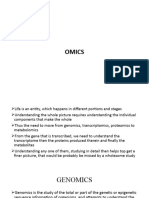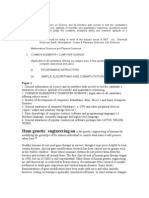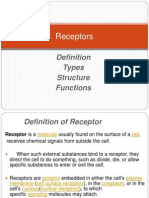Human Genome Project Questions and Answers
Human Genome Project Questions and Answers
Uploaded by
Flora Anne R. PalabricaCopyright:
Available Formats
Human Genome Project Questions and Answers
Human Genome Project Questions and Answers
Uploaded by
Flora Anne R. PalabricaOriginal Description:
Copyright
Available Formats
Share this document
Did you find this document useful?
Is this content inappropriate?
Copyright:
Available Formats
Human Genome Project Questions and Answers
Human Genome Project Questions and Answers
Uploaded by
Flora Anne R. PalabricaCopyright:
Available Formats
When was the HGP initiated and completed? Who were the proponents?
The HGP was started in October 1990 and finished in 2003. It was directed by Ari Patrinos, head of the Office of Biological and Environmental Research, and Francis Collins. Why is it important to know the sequence of the human genome? There are several benefits and potential medical and biotechnological advances that can stem from knowledge of the human genome. These include tests for genetic predisposition to various diseases like breast cancer, liver diseases, and more; easy access (for researchers) to the structure and function of any gene they want to know about; development of new therapeutic procedures; and better accuracy in tracing our evolutionary path. How are gene linkage maps and physical maps of the genome made? For the gene linkage maps, a linkage map of many thousand evenly spaced genetic markers on the chromosomes is made. The order and spacing of the markers are based on recombination frequencies. The markers may be genes or other identifiable sequences like RFLPs or microsatellites (short repetitive sequences). For the physical maps, the distances between markers are expressed in a physical quantity, such as the number of nucleotides along the DNA. The DNA of each chromosome is cut into a number of identifiable restriction fragments, and the original order of the fragments in the chromosome is determined using chromosome walking. The DNA fragments used for physical mapping are prepared by cloning. After they are cut, they are only about 1,500 base pairs long, short enough for easy sequencing. What are the uses of the technique called chromosome walking? In chromosome walking, a known gene is marked by a probe and then cut by two different restriction enzymes then cloned to produce two libraries with overlapping fragments. Probes are then used to mark the ends of each fragment that overlap with the next fragment; the areas marked by the probes become known sequences. This method is used to map genes physically. What issues attend the HGP? The HGP has various ethical, legal, and social issues. These include fairness in the use of genetic information (who should have access to it and why?), privacy, uncertainty in gene tests for susceptibilities and complex conditions (like heart disease) associated with more than one gene, philosophical issues (can genes be associated with human behavior?), health and environmental issues caused by genetically modified food and microorganisms, and many others. What is the patent controversy related to the HGP? The criteria required for patenting gene fragments are that the discoverer(s) must identify new sequences, be able to specify the product of the sequence and the function of this product in nature, and enable one skilled in genetics to use the sequence for its stated purpose. However, most such discoverers provide vague functions for their discoveries, such as being used as a probe to discover more new genetic sequences. This fails to satisfy any of the criteria for patentingresearchers will also have a difficult time studying the discovered gene, especially when many different people hold patents on different parts of the same genomethe researcher will have to pay them all apart from his own staff to study the sequence. How can these issues be resolved? In 1990, the United States Patent and Trademark Office (USPTO) released stricter criteria which require the exact function in nature to be stated before one can earn a patent.
You might also like
- Roeland Van Wijk - Light in Shaping Life - Biophotons in Biology and Medicine (2014, Meluna) - Libgen - LiDocument430 pagesRoeland Van Wijk - Light in Shaping Life - Biophotons in Biology and Medicine (2014, Meluna) - Libgen - LiSousa De La Cruz Agnes Eleni100% (5)
- Motivation LetterDocument3 pagesMotivation LetterMaheen SaleemNo ratings yet
- CV in Tabular Format PDFDocument2 pagesCV in Tabular Format PDFNazmus Shakib0% (1)
- Barbara Rega, Fipdes Coordinator Agroparistech 1, Avenue Des Olympiades, 91744 Massy Cedex FranceDocument3 pagesBarbara Rega, Fipdes Coordinator Agroparistech 1, Avenue Des Olympiades, 91744 Massy Cedex FranceMarie GungonNo ratings yet
- BEA Scholarship Guide by @ademolavictorDocument62 pagesBEA Scholarship Guide by @ademolavictorjeoladexelNo ratings yet
- The Dog GenomeDocument21 pagesThe Dog Genomediparayogagalih100% (1)
- International Baccalaureate (IB) Database Questions Biology HLDocument20 pagesInternational Baccalaureate (IB) Database Questions Biology HLTonia von HugoNo ratings yet
- Letter of MotivationDocument2 pagesLetter of MotivationExpert CV100% (1)
- Molecular Biology Fourth Edition Chapt01 LectureDocument18 pagesMolecular Biology Fourth Edition Chapt01 LecturePandit JiNo ratings yet
- Acceptance Letter by Chongqing UniversityDocument1 pageAcceptance Letter by Chongqing UniversityM Rameez Ur Rehman100% (1)
- Motivation Letter For DenmarkDocument3 pagesMotivation Letter For Denmarkmanjoey984100% (1)
- Motivation Letter PDFDocument1 pageMotivation Letter PDFSonni Maurit BenuNo ratings yet
- What Made You Pursuing A PHD?Document7 pagesWhat Made You Pursuing A PHD?Marlyn Jay Sabaybay NapiñasNo ratings yet
- Motivation Letter For ErasmusDocument1 pageMotivation Letter For ErasmusArcangela Quaintrelle100% (1)
- Contents HGPDocument11 pagesContents HGPayushmanpriyadarshi10No ratings yet
- The $1000 Genome: Ethical and Legal Issues in Whole Genome Sequencing of IndividualsDocument10 pagesThe $1000 Genome: Ethical and Legal Issues in Whole Genome Sequencing of IndividualsAquaNo ratings yet
- Genome Project 1Document2 pagesGenome Project 1api-243328977No ratings yet
- What Is Genomics?Document10 pagesWhat Is Genomics?Sahuf KhanNo ratings yet
- Human Genome ProjectDocument22 pagesHuman Genome Projectansh664499No ratings yet
- Ethical Issues of The Human Genome ProjectDocument7 pagesEthical Issues of The Human Genome Projectsam_max_bladerunnerNo ratings yet
- Human Genome ProjectDocument4 pagesHuman Genome Projectzari_pak2010No ratings yet
- TINKUDocument13 pagesTINKUhayotoyogeshNo ratings yet
- Human Genome Project and Genetic TestingDocument26 pagesHuman Genome Project and Genetic TestingonikkNo ratings yet
- 12 BioDocument2 pages12 BioJdjdjxjdjNo ratings yet
- Gene CloningDocument17 pagesGene CloningOmaraye JoshuaNo ratings yet
- Human Genome Project Class 12Document7 pagesHuman Genome Project Class 12davidkumar54dk100% (1)
- Omics IntroductionDocument25 pagesOmics IntroductionMarlvin PrimeNo ratings yet
- HGPDocument3 pagesHGPSnegapriya SivaramanNo ratings yet
- JHV 7 Ikw N2 PDocument7 pagesJHV 7 Ikw N2 Pnolerek166No ratings yet
- Human Genome ProjectDocument17 pagesHuman Genome Projectanon_306048523No ratings yet
- Gene MappingDocument3 pagesGene MappingAshok KumarNo ratings yet
- Overview of the Human Genome ProjectDocument4 pagesOverview of the Human Genome Projectmanalrubab182No ratings yet
- Genomics and Its Impact On Science and Society: A PrimerDocument12 pagesGenomics and Its Impact On Science and Society: A PrimerAdan VegaNo ratings yet
- Personalized Medicine 27.11.2024Document26 pagesPersonalized Medicine 27.11.2024Ruba AhmedNo ratings yet
- Genomes: What Makes Up A GenomeDocument8 pagesGenomes: What Makes Up A GenomeDaniel BerryNo ratings yet
- Human Genome ProjectDocument5 pagesHuman Genome ProjectKyle Ambis SyNo ratings yet
- Biology Investigatory ProjectDocument16 pagesBiology Investigatory ProjectdivyanshsinghalokNo ratings yet
- Human Genome ProjectDocument11 pagesHuman Genome ProjectAmaraaZoyaNo ratings yet
- Experiment No: 1 AimDocument13 pagesExperiment No: 1 AimSiddharth BiswalNo ratings yet
- Human GenomeDocument35 pagesHuman GenomeSafia DurraniNo ratings yet
- Black & White Deliver Card (1) - WPS OfficeDocument28 pagesBlack & White Deliver Card (1) - WPS Officelinkgogo69No ratings yet
- Evolution of GenomeDocument47 pagesEvolution of Genomehurainsahar21No ratings yet
- Human Genome Project 2019Document45 pagesHuman Genome Project 2019gshasantopalNo ratings yet
- Team3 EVI4 FGyBDocument8 pagesTeam3 EVI4 FGyBmimilaNo ratings yet
- Hum Genetic Engineering An: Paper-1Document4 pagesHum Genetic Engineering An: Paper-1vniranjan66No ratings yet
- Human Genome Project (Recovered)Document8 pagesHuman Genome Project (Recovered)Usama Jutt SandhilaNo ratings yet
- Methods in Statistical GenomicsDocument161 pagesMethods in Statistical GenomicsAlexander ClaussenNo ratings yet
- Unit 1 Basic Components of Human GeneticsDocument32 pagesUnit 1 Basic Components of Human Geneticsmohamed.puntforensics100% (2)
- Genetics 1.1 ResumeDocument102 pagesGenetics 1.1 ResumemiertschinkNo ratings yet
- Genome SequencingDocument19 pagesGenome SequencinguehdhdndNo ratings yet
- The Human Genome ProjectDocument4 pagesThe Human Genome ProjectSiti Aminah SilviNo ratings yet
- Curs Optional Genetica Medicala Si Biologie MolecularaDocument72 pagesCurs Optional Genetica Medicala Si Biologie MolecularaIulia NiculaeNo ratings yet
- Human Genome Project Fridovich 2023Document6 pagesHuman Genome Project Fridovich 2023Santiago Castro HernándezNo ratings yet
- Anshumala Ahaturvedi 1Document19 pagesAnshumala Ahaturvedi 1priyanshu8900ooNo ratings yet
- Age Piche PrintDocument3 pagesAge Piche PrintSYED ADNANNo ratings yet
- The Human Genome ProjectDocument22 pagesThe Human Genome ProjectAashianaThiyam100% (1)
- Unlocking The Genetic Blueprint of Humanity: Goals of The Human Genome ProjectDocument5 pagesUnlocking The Genetic Blueprint of Humanity: Goals of The Human Genome ProjectkhushihkpsNo ratings yet
- Human Genemoe ProjectDocument14 pagesHuman Genemoe Projectamaya mohantyNo ratings yet
- Biology ProjectDocument22 pagesBiology Projectsiddharthsaji07No ratings yet
- Human Genome Project Drug DevelopmentDocument11 pagesHuman Genome Project Drug DevelopmentfinNo ratings yet
- GenomicsDocument8 pagesGenomicsPRATAPNo ratings yet
- Note Jan 30 2014Document8 pagesNote Jan 30 2014api-243334077No ratings yet
- English - HaibunDocument4 pagesEnglish - HaibunFlora Anne R. PalabricaNo ratings yet
- Econ 198 - Palabrica - Essay # 1Document2 pagesEcon 198 - Palabrica - Essay # 1Flora Anne R. PalabricaNo ratings yet
- Shareholder vs. Stakeholder TheoryDocument9 pagesShareholder vs. Stakeholder TheoryFlora Anne R. PalabricaNo ratings yet
- Bio Reaction Paper - Understanding SexDocument2 pagesBio Reaction Paper - Understanding SexFlora Anne R. PalabricaNo ratings yet
- Echoes Article - Tackling The TabooDocument2 pagesEchoes Article - Tackling The TabooFlora Anne R. PalabricaNo ratings yet
- La Danse Des MasquesDocument35 pagesLa Danse Des MasquesFlora Anne R. PalabricaNo ratings yet
- It's Okay To Be Gay: A Children's StoryDocument11 pagesIt's Okay To Be Gay: A Children's StoryFlora Anne R. PalabricaNo ratings yet
- Desire To Learn BiochemistryDocument7 pagesDesire To Learn BiochemistryVijayabaskaran MNo ratings yet
- Sample Exam QuestionsDocument4 pagesSample Exam QuestionsmsinghmsNo ratings yet
- Ono Et Al 2015 Scientific ReportsDocument10 pagesOno Et Al 2015 Scientific ReportsDaisuke OnoNo ratings yet
- SeizuresDocument6 pagesSeizuresCzara DyNo ratings yet
- Cfx-96 Sole Source FinalDocument2 pagesCfx-96 Sole Source FinaldnajenNo ratings yet
- Infant HIV TestsDocument5 pagesInfant HIV TestsProf Rakesh SharmaNo ratings yet
- Chapter 7: Nucleic Acids: 7.1: DNA Structure and ReplicationDocument5 pagesChapter 7: Nucleic Acids: 7.1: DNA Structure and ReplicationMariamNo ratings yet
- Receptors: Types Structure FunctionsDocument44 pagesReceptors: Types Structure Functionsmaham1085No ratings yet
- Bioinformatica Taller 1Document50 pagesBioinformatica Taller 1JONATHAN RUIZ PANTEVISNo ratings yet
- MDocument9 pagesMNafeesa KousarNo ratings yet
- Dr. Alisha Noreen Lecturer Iqra UniversityDocument22 pagesDr. Alisha Noreen Lecturer Iqra UniversitypashaNo ratings yet
- Biology (Mitosis Cell Division)Document3 pagesBiology (Mitosis Cell Division)Harry ParconNo ratings yet
- 085 42 Final Biologi t4 Fasa 2 Dlp-3-34Document32 pages085 42 Final Biologi t4 Fasa 2 Dlp-3-34SUZIANA BINTI DERIS KPM-GuruNo ratings yet
- Non-Sickle HB Variants.091611Document44 pagesNon-Sickle HB Variants.091611Sumihar PasaribuNo ratings yet
- Squamous Cell CarcinomaDocument18 pagesSquamous Cell Carcinomausman tariqNo ratings yet
- STARlet IVD - PreviewDocument6 pagesSTARlet IVD - PreviewtotalwarchikNo ratings yet
- M.Sc. PART II SYLLABUS - MICROBIOLOGY PDFDocument33 pagesM.Sc. PART II SYLLABUS - MICROBIOLOGY PDFDhansukh PatelNo ratings yet
- Affinity ChromatographyDocument279 pagesAffinity ChromatographyJemal seidNo ratings yet
- 2a.BioinfoServerDatabase (Proteomics)Document50 pages2a.BioinfoServerDatabase (Proteomics)Quicker QuickNo ratings yet
- M SC Entrance (Human Genomics) - Panjab University 2013 (Key)Document13 pagesM SC Entrance (Human Genomics) - Panjab University 2013 (Key)ashaNo ratings yet
- LESSON 1: Enzymology: OutlineDocument8 pagesLESSON 1: Enzymology: OutlineErick PanganibanNo ratings yet
- RDT QuestionsDocument5 pagesRDT QuestionsKedar SharmaNo ratings yet
- Intercellular Communication and Signal TransductionDocument20 pagesIntercellular Communication and Signal TransductionBerkaahh ShoppNo ratings yet
- Insulin Biology J Synthesis and SecretionDocument33 pagesInsulin Biology J Synthesis and Secretionakash kondapalliNo ratings yet
- Biochemistry NOTEDocument9 pagesBiochemistry NOTEAbdulrahman YakubuNo ratings yet
- Tuesday 19 May 2020: Biology BDocument28 pagesTuesday 19 May 2020: Biology BAyaNo ratings yet
- Metabolic Pathways Poster PDFDocument1 pageMetabolic Pathways Poster PDFAlex DatsiukNo ratings yet
- 2H-MT - A.Y. 2022-2023 Page 1 of 10Document40 pages2H-MT - A.Y. 2022-2023 Page 1 of 10Ham BurgerNo ratings yet
































































































